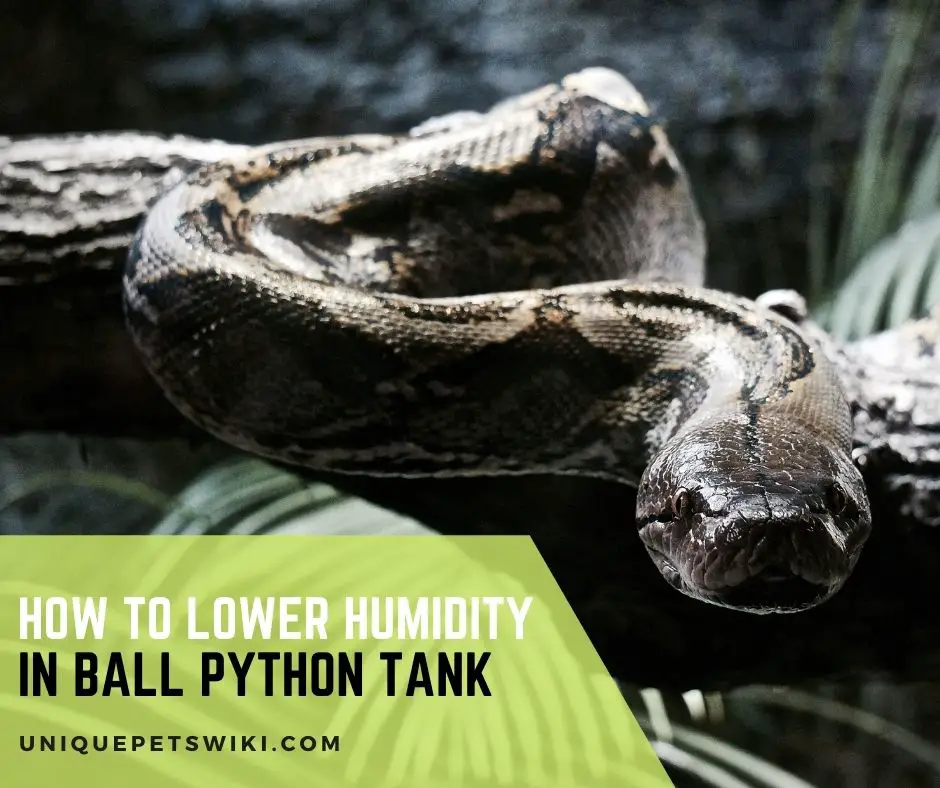Humidity is necessary for both humans and reptiles to survive. If the atmosphere has no water, the temperature of the earth’s surface would be colder.
It is important to create an environment for your pet that has the ideal humidity levels for him to stay healthy and happy.
Your ball python will be uncomfortable and prone to a variety of health problems if the humidity level becomes too high.
Learn how to reduce humidity in the enclosure of your ball python and maintain optimal levels in the future in this article.
This article has been reviewed by Dr. Gospel. Read more about our knowledge control process here.
Contents
How Do You Know If Ball Python Humidity Is Too High
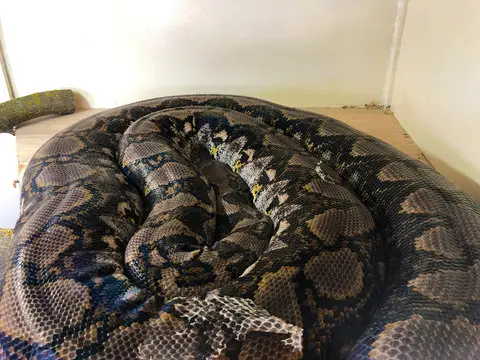
The natural environment of your ball python is hot and humid. Their skin stays moisturized, and their respiratory tract stays wetly attributable to the natural moisture in the air.
This implies that when bringing a ball python into a confined enclosure, humidity should be kept between 50 and 65 percent.
Going above 70% is too high and can lead to respiratory infection for your pet.
You will want to provide your python with both a hot and a cold side so it may wander about the enclosure like it would in the wild.
The humidification level on the cold part of the enclosure will be lesser than the warm part. You must keep both sides of the room at the proper humidity levels.
How to Measure Humidity
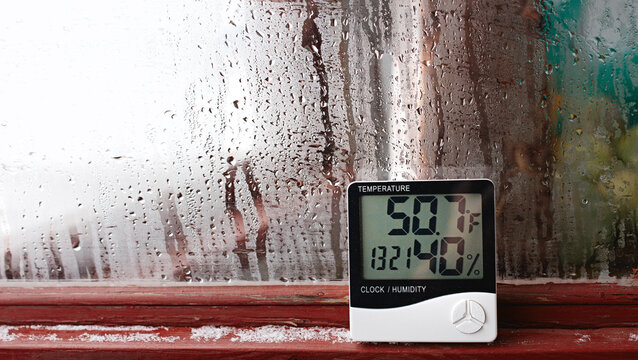
A thermometer and hygrometer are the finest tools for measuring humidity in a ball python enclosure.
Different reptiles, including ball pythons, require different humidity levels, and a hygrometer may assist you in keeping track of and controlling the ideal humidity levels.
A moldy enclosure or skin problems can occur from too high humidity, while insufficient humidity can cause shedding problems, dehydration, and even death in your reptile.
It might be difficult to find the correct thermometer and hygrometer for your reptile, but do not worry. Other reviews and online articles are discussing their features.
Also read: When do ball pythons shed? Frequency? 04 TIPS to Help Them Safety Shed
What Happens If Ball Python Humidity Is Too High?
If you see puddles of water surrounding your ball python’s enclosure, the humidity level is too high.
Humidity levels over 70% might easily cause a respiratory ailment. Moreover, scale rot is a bacterial infection of the ventral or belly scales that can be caused by high humidity.
If left untreated, scale rot or blister illness can be fatal. If your pet is susceptible to blister illness, the tank will smell wet and moldy. Increase the ventilation in the tank to lower the humidity.
How To Lower Humidity In Ball Python Tank
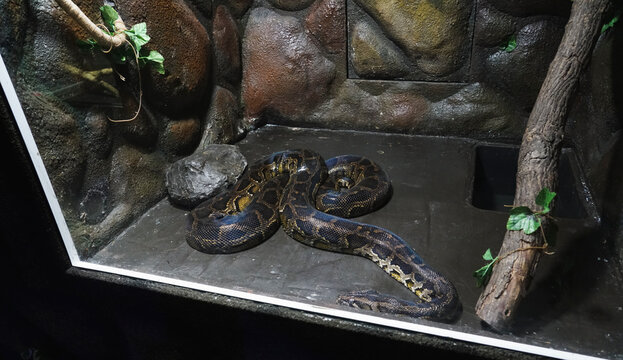
Snakes such as ball pythons require moisture, but the humidity level in the enclosure should be appropriate for your pet. The recommended humidity level for a ball python’s tank is 55-60%.
Holes for ventilation must be created in the lid to lower the tank’s humidity level.
You can also use a mesh screen as a cover for replacement. Additionally, use a drier, moisture-absorbing substrate.
In the room where you store the vivarium, use a fan or a dehumidifier. Replace the water dish at the enclosure’s cool end.
Temporary Remove The Water Bowl or Use A Smaller Water Bowl
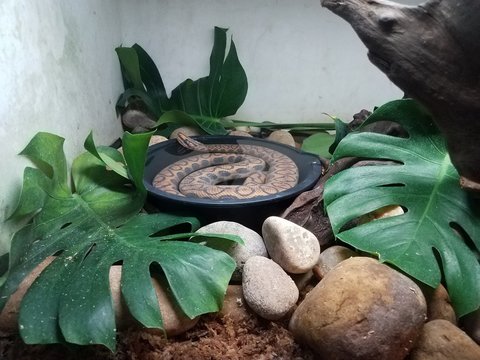
The warm end of a ball python vivarium will be heated by an under-tank heater (UTH) or an overhead heat emitter, while the cool end will be unheated.
This creates a thermal gradient for your ball python, allowing it to adjust its body temperature.
Move the water dish inside the enclosure to the cold end if it is positioned at the warm end.
Lower humidity is achieved by keeping the water dish colder. At greater temperatures, evaporation occurs more quickly.
Moreover, if you reduce the diameter of your ball python’s water dish by an inch, there will be less surface area for water to evaporate.
Your pet will require a large enough water bowl to be half-submerged in if it feels the need to bathe.
Also read: Temperatures for Ball Python (The Complete Guide)
Increased Ventilation In Your Snake’s Enclosure
Holes and vents in your pet’s enclosure let the humid air to escape leading for the cold air to flow back in.
You may look to improve ventilation in both the room and the tank. On a hot day, open the room doors and windows or put on a fan around the tank to check whether the humidity is reduced.
Alternatively, blow fresh air about the tank with a USB fan mounted on the top of the enclosure.
If your ball python lives in a plastic container, you will need to drill a few small holes in the lid and sides.
Alternatively, a mesh screen might be used to replace the plastic cover, allowing for significantly greater airflow.
Check out: Ball Python Tank Temperature: What temp should my ball python tank be?
Change The Current Heat Source
If you heat the enclosure of your ball python from above, it will be drier. You can also use heat mats or heat tapes to keep the bottom warm.
The use of heat bulbs and ceramic heat emitters allows heat to radiate downwards.
A heat mat causes any moisture on the vivarium’s bottom to evaporation, boosting humidity levels. The air will be dried out by a heat source directed downwards into the vivarium.
So, instead of a heating pad, you may obtain a ceramic heat lamp for your ball python.A heat lamp is better than a heat mat in maintaining the temperature of your ball python’s enclosure.
It can also help in maintaining the ideal humidification level and keep its tank warm at all times.
Consider Using A Dehumidifier
The humidity levels in your home may be too high for your ball python, depending on where you reside and the climate in which you live. You may obtain a dehumidifier if you have not already.
You may also use an oscillating fan to assist shift the damp air away from the enclosure of your pet ball python.
Change The Enclosure With Less Moisturizing Enclosure
Switch to a glass or wooden tank with glass doors in case you encounter a difficulty in lowering the humidity in your pet’s plastic tank.
You may choose to invest in a glass enclosure for your ball python as this is less moisturizing. Plastic retains heat far better than metal. Hot areas tend to be more humid than cold ones.
BIOTERIUM Reptile Tank | 20x12x10 Inch Glass Tank for Reptiles
- PROVIDE YOUR PET WITH A SPACIOUS, COMFY HOME - Keep your snake, lizard, or gecko comfortable and where you can see them with our 38 L (10 Gal) glass terrarium for reptiles - featuring a full front glass opening and accompanied with a realistic terrarium background.
- RAISED BOTTOM FRAME AND WATERPROOF GLASS BOTTOM FOR VERSATILE USE - A raised bottom frame leaves space for a substrate heater makes this perfect for a desert lizard terrarium. With a waterproof bottom, it's also easy to create a tropical terrarium perfectly suited to a gecko, python, or frog.
- EASILY ACCESSIBLE FOR FEEDING, CLEANING, AND DECORATING - The front doors open separately, making this reptile terrarium easily accessible for feeding and convenient cleaning, decoration, and maintenance. A specially designed lock also helps prevent escape.
- VENTILATED HABITAT WITH CONVENIENT WIRE OUTLETS - Our terrarium tank includes a removable mesh top so your pet can enjoy optimal airflow, UVB and infrared penetration, and dome lighting. Wire outlets on the side and top doors are there for your convenience.
- EASY 5- MINUTE INSTALLATION - We've included everything you need for a hassle-free, straightforward installation. With our clear instructions manual, assembly should take you only about 5 minutes!
Last update on 2022-12-29 / Affiliate links / Images from Amazon Product Advertising API
Change The Substrate (Bedding)
If you bought your ball python, it was probably advised that you use coconut husk substrate with some sphagnum moss.
These are excellent ball python substrates, however, they raise humidity levels.
Some substrates are inherently wet and transfer a lot of moisture into the air. Others are drier, absorbing moisture from the surroundings naturally and keeping the air dry.
Therefore, you may opt to change the bedding of your ball python to Aspen, newspaper, or paper pulp (such as Carefresh).
Paper towels can be used to replace any damp substrate in the enclosure. Paper towels are absorbent, quick to clean, and do not increase humidity levels.
If the substrate becomes too moist, replace it.
Zoo Med Aspen Snake Bedding (24 qt)
- Green product made from a renewable resource
- Easy to clean
- 99.9% dust free
Last update on 2022-12-29 / Affiliate links / Images from Amazon Product Advertising API
In Summary
As a ball python owner, your pet’s safety and comfortability are your top priorities. Keeping an eye on your humidity levels might help you avoid illness and disease.
If the level of humidity is high, the techniques above will help you bring the level down to a safe position that will be comfortable for your pet.
